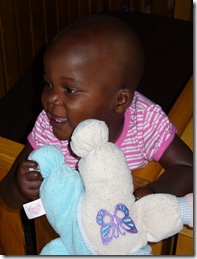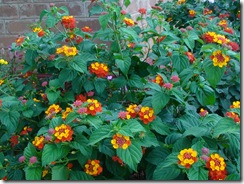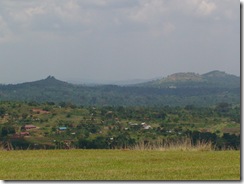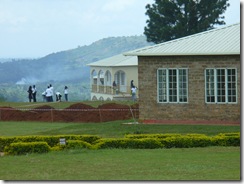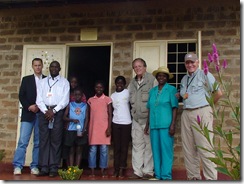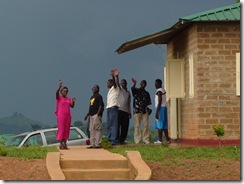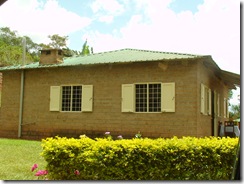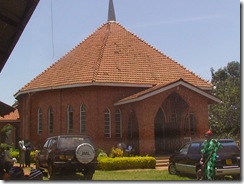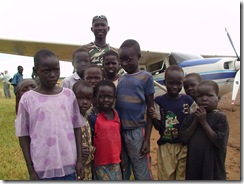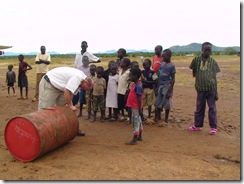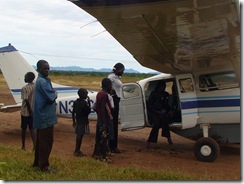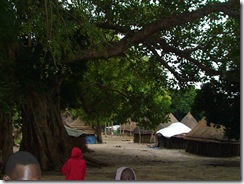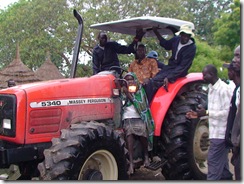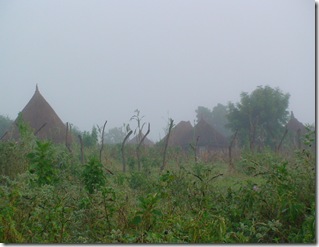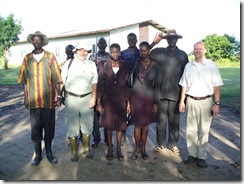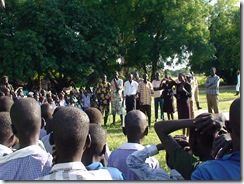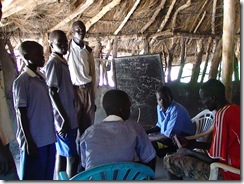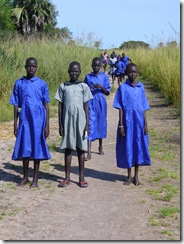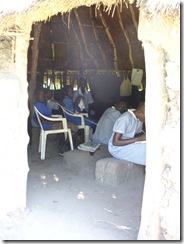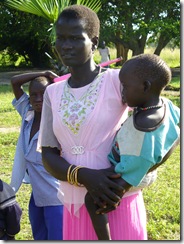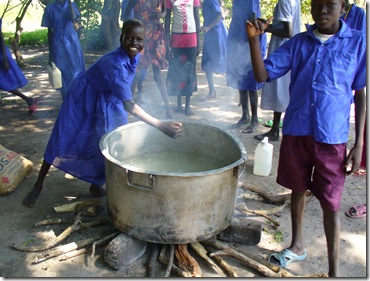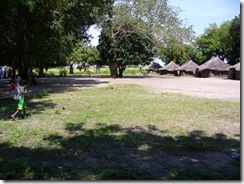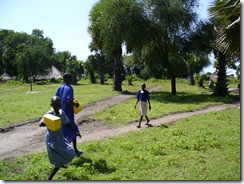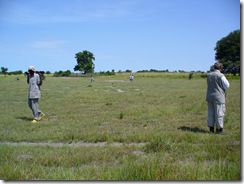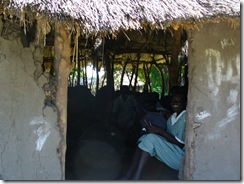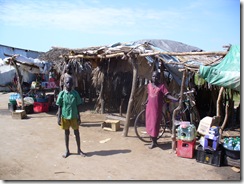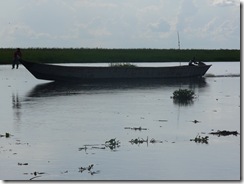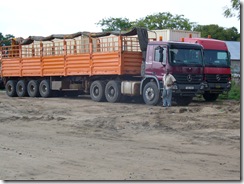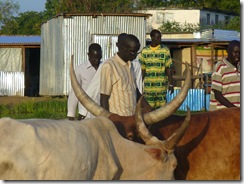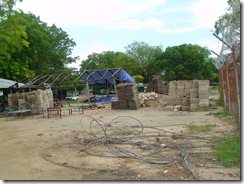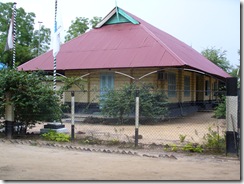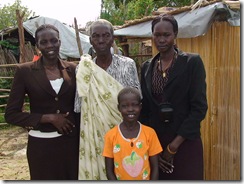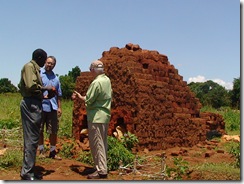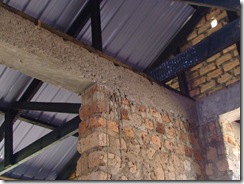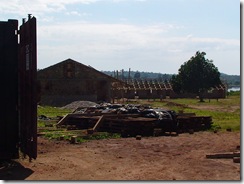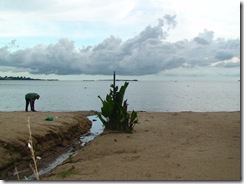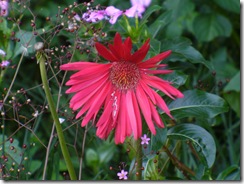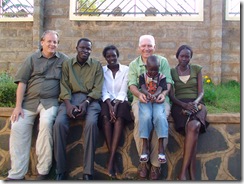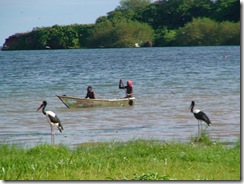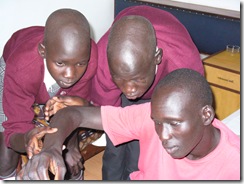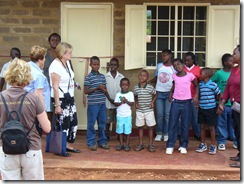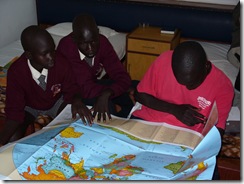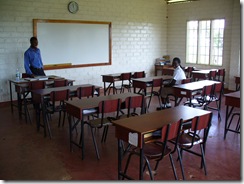Dear All:
Thanks for all your thoughtfulness and support during our trip to Uganda and Sudan. We have been back a while, but it has taken me some time to put together this report and archive. I hope that it will be a good reference in the future as we develop our project. I will update it with additional videos and information as time allows. Feel free to send me any additions and corrections that you feel will aid our effort.........
Please see the end of this report for links to the pictures, videos, conversations and nature sounds we recorded during our trip. I will post the entire journal with archive links on: http://www.gracefulseed.blogspot.com/
Sudan Trip Journal:
In the first week of our trip, we attended a major conference in Kampala Uganda, where we were given a great understanding Africa's problems, both human and technical. We were also shown a successful model for accomplishing humanitarian work in Africa.
During the second half of our trip, we went into the field, flying into the heart of Sudan, discovering for ourselves conditions there and recording our experiences to the best of our ability. Our hope is that this effort will aid us in making good decisions concerning the construction and administration of our proposed boarding school.
September 24:
We first visited the South Sudanese embassy and walked across downtown Kampala to deposit the Visa fee in a certified bank. Government Toyota SUV's drove quickly by. All seemed clean & fresh after the rains. Last nights ride in the dark into the city was thick with the smell of diesel & charcoal. In the morning light saw Spanish tile roofs and tropical plants mixed with walkers, bikers, motorcycles, cars and small buses called "matatus". Large storks, hawks, Ibis, magpies, crows and other bird in flocks glided constantly in the sky above. Young girls cleaned the streets and public gardens with long hay brooms. And yes, there are ladies who walk tall with a basket of "Goya" bananas piled high. All this created a unique urban experience.
We were picked up by the young bright eyed KPC / Watoto (Kampala Pentecostal Church / Child in Swahili) personnel for conference registration aground 11 am. We began to met people from across central Africa, Europe, Australia and America desiring make a contribution to the recovery & development of Africa.
We visited their facility near the downtown area that housed rescued infants that had abandoned with AIDS. They care for 85 children presently, after sending 15 to one of KPC's two children's villages. They now care for a total of 1500 children and have a goal to care for 10,000. They are also rescuing abused Women, who in turn are helping to run the child center and the villages. The former headquarters of the infamous Idi Amin, now has been converted for such great humanitarian work.
I was most impressed by the clear & bright liberated faces of the young Ugandans and Kenyans at the Conference, even while facing most difficult challenges, overcoming horrendous past and present problems. They were faithfully believing in God and each other, and that they can contribute in love with forgiveness & hope.
I was reminded of how smart, flexible and adaptable the young Africans are.
September 25:
Trauma of War Affected Children.
KPC sees its mission as rescuing children and women who have been victimized by AIDS & war, then to raising them to become the leaders to rebuild their broken nation. Inspired by the story of Moses who was likewise abandoned by the Nile, they call their downtown facility "Bull Rushes".
The LRA, tragically named the "Lords Liberation Army" is a terrorist Army responsible for unimaginable atrocities in Uganda, Sudan & the Congo. Joseph Kony is the"Maniacal Messianic" leader whose movement kidnaps children 10 to 12 years old and forces them to commit horrendous crimes. They are forced to kill and torture their own families, even babies at the price of their own lives. That trauma binds them in guilt and anger to his violent movement.
His "child's army" continues to terrorize extensive areas on the edges of the African Bush. There is now a genocide going on in the Congo where 5 million have died. No one in the West is even informed of this. The National Geographic had a picture of 10 killed gorillas on the front cover, and only mentioned the 5 million human murders in small print.
Forgiveness and Reconciliation
First, the Children and Mothers are provided with a truly loving and safe environment. They are placed in beautiful villages with parents, brothers and sisters. In counseling, they are then encouraged, as their nightmares and anger emerge, to forgive. They are taught to forgive their captors who abused them, their parents whodidn't protect them, and the national and international community that didn't save them. They are also taught to forgive themselves.
KPC's trauma specialist explained: the pain of that resentment is a real physical pain, destroying the chemicals of the mind that naturally produce energetic flow in the mind and create our sense of peace and well being. It is like the poison of a snakebite. Even as the surface wound heals, the poison remain, travelers to the brain and produces death. Forgiveness extracts that poison and restores mind chemistry. Hope, love and joy can then be experienced.
Forgiveness is not letting the criminal off the hook. It is getting their hook out of you.
We heard moving testimonies by children soldiers who detailed their murders, who now feel free in the love of God to have hope for the future. Also, one of the 20 wives of Joseph Kony testified. She had escaped from an indescribable hell, and was now working with KPC.
Networking, Social Work and Child Development
(KPC produced a very good manual. This will be developed later)
September 26:
Mobilizing Women
Women in Africa have absolutely no rights. They cannot own property of any kind, cannot be involved in politics. There are stories of even well-to-do women who, upon their husbands death, are stripped of everything except the clothes they are wearing. Their in-laws "lawfully" take everything - her car, her house, even her clothes.
70% of the widowed women in Africa have Aids. Sex and AIDS are taboo subjects. Even the pastors do not bring up the subject. It is a hidden truth that the reason that they avoid the subject is that many of pastors have AIDS. Most of the women with AIDS received it from their husbands. They were faithful to their husbands, but their husbands were not faithful to them.
(More later...)
****************************************************
Fundraising.
We must have vision and a strategic plan. Money follows vision. Begin small and place in motion what you need money for. Then more will be given based on the fulfillment of the initial stage and commitment to greater action. You will be given what you need for the job you have already undertaken. Funding sources will come forth in unexpected ways as you proceed according to a well though out plan.
(KPC produced a very good manual. This will be developed later)
Financing, Complete Transparency is absolutely necessary. There is a way to eliminate all possibility of corruption through modern accounting and auditing. We cannot use "cultural differences" for an excuse to be lax in regard to booking keeping and auditing. If someone does not want to show receipts then that person should not be trusted pure and simple. Integrity and trust are the most important things in regard to financing. The KPC leader of the Church does not touch any of the money. His CEO and Board decide on all expenditures. The Three "G" Test that must be passed by any leader responsible public projects are (1) the Gold, (2) the Glory, and (3)the Girls/Guys.
(KPC produced a very good manual. This will be developed later)
September 27:
We visited the (2) children's villages. Classrooms were first approached, then the the clinic, grocery store, playgrounds and round clusters of homes. A mother and 8 children occupied each home. We each ate a meal together with a family their home, all in the most beautiful setting, on top of a Ugandan mountain.
We have witnessed an amazing success story. We heard stories of the power of forgiveness in extreme situations, seen the results of it. The key is integrity and transparency. It was evident by the conference itself, opening up fully for others to partner, network with, or just emulate in full or part. They have technical staff that is also available to help others reproduce their model.
September 28:
We attended the Sudanese Church service in Kampala. We traveled from crowded city streets to narrow eroded lanes to a beautiful church. Over 1800 beautifully dressed Sudanese came to worship in Anglican/African stile. It felt very familiar, similar to the Sudanese worship services in Fargo.
We first sat in the back and then were brought to the front as special guests. The Duk County Coordinator was there, and spoke passionately to the Kampala Church. He was trying to persuade the Sudanese to come back to their villages. Many who left the refugee camps to come back to Duk were returning to the camps in concern that their children could get a better education in the camps. In one location in Duk County there are 18 teachers for 3000 children.
Later in the service, all three of us stood before the congregation and explained our project and our relationship with Joseph and the Sudanese Community. When we finished the translator spoke and everyone laughed. The joke was that he couldn't understand our North Dakota accents and just made up what he thought we said.
September 29:
Report & Rest
September 30:
We prepared to travel North.
October 1:
We left Kampala for Sudan. Loretta and Lanny Weeks (AIM-Kampala Based) met us at the airport. Lanny, one of the AIM pilots, needed to spend the day registering his car, which sounded like a major problem in Uganda. Therefore, John Mcneely flew in from Nirobi to fly us to Torit & on to Duk Payuel. Lydia, their coordinator, scheduled our flight from her base in Lokichokio, Kenya. Besides Ron, Joseph & I, we were bringing Sarah & Debbie (Joseph's relatives) to visit their village for the first time. Negotiation was necessary, because of the now (5) passengers, and the fact we had to fly in a pilot from Kenya. The cost of the flight changed from $1800 to $2700. We had brought the price back a little bit, but realized because of high costs also in Juba, we would need to shorten our stay in Sudan.
We stopped to re-fuel in Torit, Sudan. We rolled a large red fuel barrel to fill a shinny bucket with blue aviation fuel. Then we would hand the bucket to our pilot on the wing to pour it in the plane.
There in Torit as we fueled, we met Kyle Kemp, missionary from Cavalier North Dakota([ky_do_ke@hotmail.com] he has a computer connection at the UN offices). The three North Dakotans were amazed that we were there together in the middle of nowhere. Then we realized we were from the middle of nowhere, so it wasn't all that unusual, maybe even fitting.
We arrived at Duk Payuel with the entire village out to greet us. The video linked below captures most of it. But I missed filming the "jumping of a cow" (later to be sacrifice). We were swept up in a current of people, and amazingly, we, our luggage and our equipment arrived at the clinic compound on the other side of the village.
We return to the village center for a meeting under a huge beautiful tree by the chief's house. The tree's canopy kept us dry in the gentle rain. The village proudly drove out a large Massey-Ferguson tractor given to them by the Norwegian Church. I spotted rusting equipment in the village. It looked like a large compressor and possibly some drilling equipment. Ron should remember, he is so good with detail.
We spent the night at the Clinic Compound. The Clinic had a dish, generator, new cement mixer and a new well. There was an old water tower and tank, and a well that has been abandoned, because many of the towns people were killed and thrown down that well during the war. We met Samuel who seemed to be of middle east or Indian decent. He has been in charge of the clinic site maintenance for the last 18 months, hired by the John Dau Group. Samuel was educated as an electrical engineer. He operated the satellite Internet and the generator. Samuel also showed me plans for permanent guest units he hopes to build. He has experimented with mud blocks but has not yet found the best way to create them locally.
We inspected the clinic foundation problem near the swamp. There is some settlement that has cause some slab cracking and separation of the exterior siding. It will be a challenge to design and build a proper foundation for our structures, to insure their long life.
We also met David, one of the main school teachers. He was very helpful. I have linked part of his conversation below. Philip from Juba said that there are 1700 preschool and Kindergarten. 641 children are in the Primary School Students, 120 of those are orphans, now dressed in the blue uniforms. All the orphan's live with someone in the village. They have an outdoor spot for a noon mean at school.
There is no secondary school. The boys of that age hang around with nothing to do. Some do go to Cattle Camp, a huge "parking lot" of cattle on the banks of the Nile where the boys tend the herd during the wet season.
There were drums in the evening, chorus of birds and insects, and brightest stars I have ever seen. Those stars jumped down at you in 3D like none I have ever seen (it might have been the malaria medication I was taking). There was a shot heard at night. We learned the next day that there was cattle thievery going on, and the guard had fired a warning shot. A fight ensued and one of the thieves were killed. We also learn that the headmaster of the school has been missing for 4 days and presumed dead. He was walking back from Pok Top. thru the flooded grasslands six miles away.
Drums beat in the morning called the villagers to church.......
October 2:
We met at dawn and walked across the swamp to the nearby school site. We first met with the children. It was nice to see Debbie & Sarah address and encourage them. They focused especially the girls, urging them to continue to study and not get married too early. Sarah and Debbie have a team of 8 women in college with a dream (and charter underway) to establish a school for girls in Juba.
We then listened to talks expressing community needs by the Duk officials. I have a recording and video links below. Here is the short list of the needs that they hope we can help them overcome:
- 1. A Building for Duk Payuel primary school
- 2. Sponsorship for the pupils. Girls education is interrupted by parents for marriage and work.
- 3. Needs: library & a place to read (lighting); Science material, microscope, binocular & telescope; chairs & benches
- 4. Needs: printing machine for exams & reports
- 5. Teachers come a long way & need a compound.
- 120 children have no parents - it is hard for them to get basic food and clothing (52% of student don't have 2 parents and have a difficult situation).
- Only 6 volunteers; (2) caretakers & (4) cooks
I also spoke and acknowledged our appreciation for village's overwhelming greeting for us (see video). I complimented the village on it's beauty & friendliness. I also stated that although we think that we may be different, I can see by observing the children that they are the same as in North Dakota.
We were offered the existing school site to build our facility. It has a large open "square", bordered with large trees. It is open to the South, and to the east is a line of 6 classrooms, traditional wood, mud & thatch structures. Each structure lasts about (3) years because of the termites, and then must be rebuilt. The classrooms are about 15' x 18' with 2 center poles. They are ventilated at the roof line all around. They have makeshift doors and a small blackboard inside.
We were also taken to an open cooking area for the orphans, with one large pot. There, with the cows in a fenced perimeter, they had their meal provided by the community.
The site is very large, with an area to the west that can be use as a playing field. Some of the lower areas could be used for gardening. We did see many garden plots by the homes of the villagers. We photographed, videoed and surveyed the site to the best of our ability with the time allotted us. Time was short, because of the rigid flight plan.
1) orphan's greet us 2) classroom 3) mother & child 4) orphan's one meal at the school 5) David's speech
We were able to survey (3) areas for possible construction: a classroom area near the access path and existing classrooms; (2) an area for dormitories at the opposite corner; and an open playing field. Gardens could be created in various corners of the site.
Our team left Duk Payuel by 11 AM and stopped shortly in Poktap. The city administrator came to the plane to greet us. Then after a few hours in flight, we landed on a large well-groomed gravel landing strip in Bor. Six or eight foreign UN soldiers lined the runway and approached us with serious faces asking for our passports. The City Administrator came to drive us into town. After gathering a few locals to "pop the clutch", he drove us to the center of town. We walk throughout the town, stopping by his family compound where we sat with his family. His friendly children sat on our laps. Later, we gathered in the shade of a tree and enjoyed our soda, beer and water. Ron & I were so thirsty. The girls drank only a half a bottle of soda and let it sit there in front of me. I had to control myself not to grab it.
We spent the night at a tent hotel. We talked with the hotel proprietors Anne and Rochelle at sunset about Sudan, their town of Bor, and the hotel project they were building. There under the stars in Bor I had the best night's sleep I had had in a long time. We were also able to meet Sarah's mother and grandmother in Bor. I will always remember sitting together in there home to escape the rains.
October 3:
We had an "active - updownupdown" six hour drive through the Sudd from Bor to Juba. The road was extremely rough. We passed traditional huts just off the road in many locations on the way down. I will post a video in the near future so you can see how rough the road is! Naked herdsmen walked "free and loose" down the road with their cows (no video here, sorry). We enjoyed a snack of roasted maize with the taste of popcorn and drank warm soda.
There were a number of check points gathering tolls. We approached Juba on the bad side of town, where check-points were more aggressive, some with questionable authority. We rode around Juba, had lunch at a restaurant owned by Joseph's friends and met with John Dau's brother John Deng. We are not certain if he will be able to contribute services to our project.
Our team spent the night the in "Grand Hotel" owned by Arabs from "Eritrea". We paid $200 per night for a room with mobile home trim and broken fixtures. Juba is very expensive. Ron mentioned that it reminded him of a wild west town. It was difficult to recognize any businesses or venders that would be able to help us get materials and services to Duk. We were told repeatedly that most of the supplies came from Kampala.
************************************************************************
October 4:
We arose and waited for John Dau's brother to take us on a tour of his businesses. He didn't arrive by the designated time, and we again found ourselves pressed by the flight time. We did make a quick trip by ourselves to see John's block production lot. We viewed his supply and (2) block making machines.
There was quite a crowd trying fly out of Juba. Joseph's contact Paul help us at the airport. Joseph said that he is and will be a major support er of our project. We arrived in the afternoon in Entebbe where we would spent the final days of our trip, at the Areita Hotel on Lake Victoria.
October 5:
Joseph left us to meet his contacts. Ron & I spent the day on the shore of Lake Victoria. We witnessed beauty of amazing flora and fauna. If the human problems in Africa could be solved, it would be a place everyone would desire to visit!
October 6:
Ron called Steve Hoyt, Project Manager on loan from Engineering International Ministers (EAM Eastern Africa) to African Children's Choir / Music for Life. He is building a school with dorms on the other side of Entebbe. Ron explain the purpose of our trip and Steve graciously offered to come by, pick us and show us his project.
His school is located very near the home of the Queen of the Bugandan Tribe, the dominant tribe in the Kampala area, one of the 58 tribes in Uganda. Steve said the longer you are in Uganda, the more you see the differences in the tribes and realize the source of conflicts. Sudan has even a greater variety of tribes.
Steve emphasized the importance of designing a project to be build by African techniques. If you use American technology, and then leave, your projects cannot be repaired by African workers. The classrooms that Steve is constructing are 20' x 30', with Large windows 60"wide & 80" high, with 3' x 7' doors. A Ring Beam above doors and windows ties the complete perimeter of the building together. Footings are poured down 3' with a brick wall on set on the footings. A Large rock base is provided under all slabs (we saw this at Watoto also), and sand and gravel are added on top of the rock. A (6) mil plastic barrier is placed on top of the gravel with (2) concrete pours and a final finish pour. I believe he said that all concrete is mixed by hand on the ground. Ron & I now question if I heard right, because it seems like a very difficult way to work with concrete.
The walls had metal strap every 3 courses (2 to 4). He stated that his most important piece of equipment was a gas driven vibrator for concrete pours, to insure the concrete in the mesh filled concrete beams bonded well into the aggregate. Steve did have some very nice exposed concrete and beams he was constructing on a portico and down a central corridor with lighting and ventilation. In most other places the concrete beams and wood trusses would be concealed behind a plaster wall and ceiling system. Wood windows will be set into block that has been broken back. Iron windows would be bolted into the block.
Steve encouraged artful building, and saw it as his mission to inspire the craftsmanship in his workers. He stated that it is difficult to convince African workers that people really care about the quality of work they are performing. I will add video footage of his comments in the near future.
In the Evening we went for dinner at Sarah's home and met her large family. Debbie came after her tests at school. After a tasty chicken & pasta meal, we enjoyed taking many pictures in the cool of the evening in the garden around their lovely home. We walked together a couple of blocks to the heavily rutted but very busy dirt road. Many walked, cycled and drove down that road. The girls met another of their close friends walking down the road as they had done throughout the trip (they seemed to know everybody in Africa).
We returned to Entebbe in a matatu, a small 15 seat bus, one of the main forms of transport in Kampala. 15 people sharing the cost of a ride make transport very economical. (I did miss all the disciplined Americans, driving faithfully in their lanes and obeying traffic signals.)
The most inspiring events for me during the trip were witnessing the enthusiasm of Ron and other westerners who were building personal relationships of trust and support with Africans. Ron's boys James, Simon and Moses spirits soared as they were showered with attention. Ron showed his constant concern for the boys as any parent would. The woman next to us on the small bus was overcome with emotion as she realized that the village home we were approaching was the one built with her and her late husband's donation and the family on the front step was the family she was sponsoring.
Watoto has and excellent system for making the offerings made to Africa personally satisfying and meaningful by removing untrustworthy middlemen and creating transparent operations . I was impressed by the way that they "walked their talk", in approaching some of the most difficult problems there are to encounter.
I was also impressed with Joseph's network of contacts. I always felt safe, as the highest city official in every city ( Duk Payuel, Poltap Bor & Juba) came out to greet and guide us. Joseph's friend Paul, who help us with our flight to Entebbe, was especially impressive.
We still are left to ponder the best way of getting construction services and materials to Duk. We will keep this in mind as we contemplate the design and construction of the facility in the near future.
October 7:
Ron & I reviewed our time in Uganda & Sudan, plotted co-ordinates taken on Ron's GPS and begun a site diagram to aid in planning. We hoped to have dinner with Steve Hoyt before the trip to the Entebbe airport, but Steve must have had something come up. He has a young family and lots of construction problems to solve. We left for the airport to prepare for our 10:30 pm flight.
Complete Journal:
Here is the Link to the complete Africa 2008 Trip Journal: http://www.gracefulseed.blogspot.com/
Photos:
I have copied Ron & my photos to (2) web albums. Click on the picture for the two links:
 |
 |
| Sudan Sept 22-Oct 8 2008 Trip (2) |
Videos:
click on this link: http://www.google.com/s2/sharing/stuff?user=114980725009703374301
Conversations:
http://drop.io/AppaSudan/asset/02-africa08-village-council-meeting-in-rain-under-tree
http://drop.io/AppaSudan/asset/04-africa08-morning-meeting-at-school-site
http://drop.io/AppaSudan/asset/05-africa08-morningmeeting-at-school-site-2
http://drop.io/AppaSudan/asset/03-africa08-school-teachers-converstation
These are uploaded to the www.drop.io/appaSudan site
Nature Sounds of Sudan & Songs:
http://drop.io/AppaSudan/asset/01-africa08-chilldren-sing-at-arrival-in-duk-payuel
http://drop.io/AppaSudan/asset/morning-sounds-in-duk-payuel
http://drop.io/AppaSudan/asset/nature-sounds-of-bor-drums-singing
These are uploaded to the www.drop.io/appaSudan site
